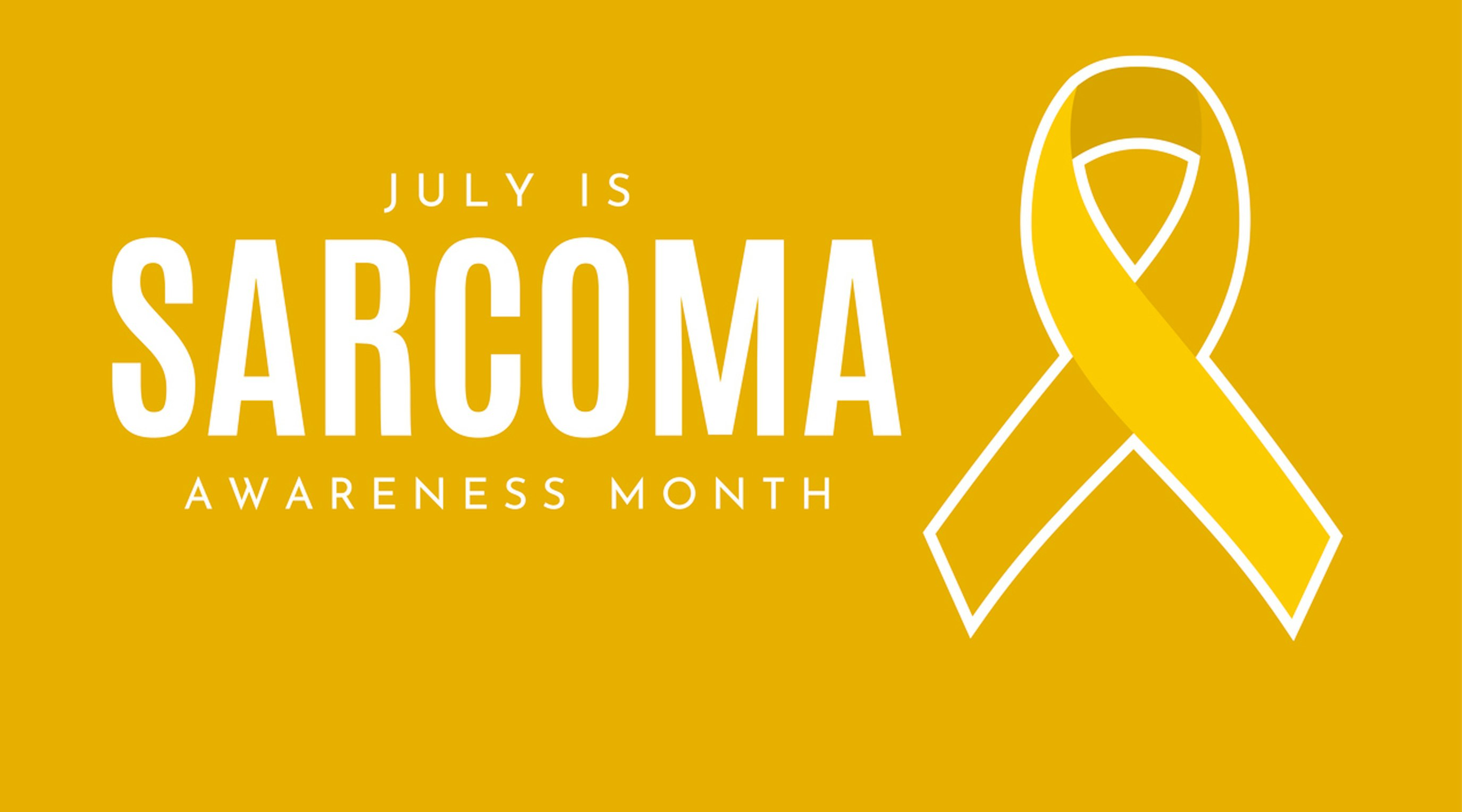Compassionate care for the loneliest cancer: Medical cannabis and sarcoma.
11 min read
Lucy MacKinnon
There are 100 different subtypes of sarcoma, and collectively they account for fewer than 2% of all cancer diagnoses in the UK. But still, each and every day 15 people in the UK receive the news that they’ve been diagnosed with sarcoma, also known as the loneliest cancer.
Contents
Considering July is Sarcoma Awareness Month, we thought now would be a fitting time to bring more attention to the different kinds of sarcoma, the research being conducted, and the treatment options available designed to kill cancer cells, and soothe secondary symptoms.
Our own research shows that only 14% of UK adults were aware medical cannabis can be prescribed to patients with cancer to help with support, and, we don’t think this figure is high enough - so it’s where we’d like to focus our attention today.
But first, it is important to note that medical cannabis is not a first line treatment option for cancer or sarcomas, nor is it a cure.
Medical cannabis can however be prescribed by specialist doctors in the UK to patients who have been deemed eligible, to alleviate the vomiting and nausea, pain, sleep and appetite concerns, or low mood or anxiety that often accompanies sarcoma diagnosis’, and, the conventional methods commonly used to combat cancer.
So, what is sarcoma?
Sarcoma is a rare cancer that develops in bones or soft tissues, like muscles, nerves, fat, blood vessels, and deep skin or fibrous tissues.
Depending on the tumour’s location, they are categorised as either bone sarcomas (also known as bone cancer) or soft tissue sarcomas. Within these two classifications, there are 100 different subtypes.
How common is sarcoma?
Not very common. Of all sarcomas, soft tissue sarcomas are diagnosed most frequently in England, and in 2019 they accounted for 87% of all sarcomas diagnosed.
Of the 4,472 soft tissue sarcoma’s diagnosed, the most common subtypes were gastrointestinal stromal tumour (GIST) (927 cases), undifferentiated sarcoma (839 cases), leiomyosarcoma (498 cases) and liposarcoma (391 cases).
On the other hand, 13%, or, 662, of the sarcomas diagnosed in 2019 in England, were bone sarcomas, with the most prevalent being chondrosarcoma (197 cases), followed by osteosarcoma (158), and Ewing’s Sarcoma (101).
Because of each subtypes' rarity, it’s extremely rare for patients to meet another with the same type of sarcoma, and this is why it’s often referred to as the loneliest cancer.
What symptoms does sarcoma cause?
Sarcoma symptoms can vary depending on the tumour’s location, and the anti-cancer treatments being used, however typical symptoms include:
- Unexplained fatigue
- Reduced appetite
- Weight loss
- Bone pain
- Tummy pain
- Persistent cough
- Low mood
How is sarcoma typically treated?
Usually when a person receives a sarcoma diagnosis, it’s recommended they have surgery to remove the tumour, often as well as adjunctive treatments like radiotherapy and chemotherapy.
Not all soft-tissue sarcomas respond well to chemotherapy, but some do, and so the decision of whether to use radiotherapy or chemotherapy typically depends on the patient's particular sarcoma subtype.
Sometimes these adjunctive treatments are prescribed before surgery, to help shrink the tumour and destroy cancer cells before their operation. Then, during surgery, the tumour is removed along with a margin of surrounding tissue. This is to reduce the likelihood of the cancer coming back.
After surgery, if the sarcoma was classed as an intermediate or high-grade tumour, or the surgeon was only able to remove a small margin, radiotherapy or chemotherapy may be recommended again, to reduce the risk of cancer reoccurring.
Often, sarcoma cancer survivors also have extensive rehabilitation therapy after their cancer has gone into remission. This can involve occupational, speech and language, or physiotherapy, mental health counselling, or referral to a dietician or nutritional support.
What are the side effects of traditional cancer treatments?
While this conventional route has proven to be successful for many sarcoma cancer survivors, both radiotherapy and surgery can damage the lymphatic system, and chemotherapy, radiotherapy, and surgery are often unpleasant to experience because of their side effects.
Common side effects of chemotherapy include fatigue, nausea and vomiting, reduced appetite, hair loss, anaemia, constipation and easy bruising and bleeding. Radiotherapy can also cause a whole host of side effects including sore skin, fatigue, nausea, discomfort when eating, weight loss, diarrhoea, stiff muscles and joints, and hair loss. And amongst other more complicated side effects, even successful surgeries can cause pain, bruising, bleeding, inflammation and infections, and blood clots.
Can medical cannabis be prescribed for sarcoma support in the UK?
Yes. In the UK, patients who have found conventional or licensed treatment options ineffective at meeting their needs when it comes to cancer support may be considered suitable for cannabis-based treatments.
While medical cannabis is not a treatment for cancer like sarcoma, both real-life evidence and clinical investigations have displayed positive findings when cannabis-based products are used in conjunction with traditional cancer treatments.
Real-life evidence demonstrates medical cannabis can take a multifaceted approach, targeting a number of symptoms at once - and so, medical cannabis is fast becoming a popular treatment choice amongst patients with cancer.
The clinical studies referenced in the subheadings below provide some insight into the potential effects and benefits of medical cannabis when used in cancer treatment plans.
It is important to note that while these studies show impressive findings, they may not meet the rigorous standards required by UK regulatory bodies such as the Medicines and Healthcare products Regulatory Agency (MHRA) and the National Institute for Health and Care Excellence (NICE).
Consequently, the findings from these studies are not considered robust or comprehensive enough to support definitive medical claims regarding the efficacy of cannabis for medical use. And so, any conclusions drawn should be interpreted with caution, and viewed as preliminary rather than conclusive evidence while research in this area continues.
Medical cannabis and cancer: nausea, vomiting, and appetite
More than 80% of those who have undergone chemotherapy experienced nausea and vomiting while receiving treatment. Usually, this is combatted using a strict diet of bland, room temperature foods that are served in small portions, or by taking conventional anti-emetics, but since 2018 medical cannabis has been an alternative, and available, option to suitable patients in the UK.
This is because medical cannabis has shown to be effective in managing, or reducing, nausea and vomiting associated with cancer treatments. In fact, in a phase 2 randomised controlled trial conducted in Australia in 2020, a quarter of chemotherapy patients who received medical cannabis reported experiencing no vomiting or nausea. In total, 81 participants enrolled, and the study ran for two and half years.
Another study of interest in this area was conducted in 2019, and it analysed the data held by Minnesota’s medical cannabis program. According to their data, within the first four months of treatment, patients with cancer using cannabis therapeutically reported their vomiting had reduced by around 50%.
Medical cannabis has also shown potential in aiding appetite improvement, especially amongst those with serious illnesses like cancer or HIV. This is because THC, cannabis’ psychoactive component, has demonstrated the ability to act as an appetite stimulant, and essentially ‘switch on’ the sensation of hunger in the brain.
Medical cannabis: cancer pain
Experiencing pain is another very common symptom of sarcoma, and it's also a common side effect of conventional anticancer treatments. In fact, the British Medical Journal states over 50% of people receiving these treatments report cancer-related pain, which can have a knock-on effect on sleep and mood.
Although research in this area is still ongoing, at the moment researchers believe medical cannabis is able to interact with the part of the brain that is responsible for pain perception and regulation, and reduce the severity, or recognition, of pain.
This can have a significant impact on day-to-day life, and an analysis of the Canadian Quebec Cannabis Registry demonstrates this. This analysis showed at 3, 6, and 9 month follow-up appointments, patients with cancer pain reported significant improvements in their overall pain severity, average pain intensity, and level of pain interference with their daily life when using cannabis-based products.
The study also found participants' need for other prescribed medicines fell, and it was noted that the rate of opioid and medication use consistently decreased at each follow up.
Medical cannabis and cancer: sleep and mood concerns
Unfortunately, insomnia, anxiety, and depression are also common side effects, or secondary symptoms, of conventional cancer treatments, and cancer diagnosis. But, research and real-life evidence indicates medical cannabis may be able to help here too.
For example, in 2019 a study involving cancer patients suffering from anxiety and depression revealed average anxiety scores dropped from 9 to 6, and depression severity scores dropped from 19 to 15, when they were treated with medical cannabis.
Data from the UK’s largest observational study of medical cannabis also shows positive results in this area, with PHQ-9 depression scores halving on average within 3 months of medical cannabis treatment.
There is also reputable research to demonstrate the powerful potential medical cannabis can also have on sleep when applied appropriately. For example, one double-blind placebo-controlled trial showed an 80% improvement in quality of sleep was noted with a medical cannabis oil, and another small-scale placebo-controlled study showed insomnia severity scores decreased by 26% using a cannabinoid extract.
Side effects of medical cannabis treatments
While medical cannabis is generally well-tolerated, like any medication, there are side effects that can occur. This is why it's important the application of medical cannabis is overseen by qualified healthcare professionals like those who work for Releaf, and regular check-in appointments are conducted, so treatment plans can be adjusted in case of their occurrence. At Releaf, once patients have had their initial consultation and one month follow-up, check-ins with the clinical team are required in 120 day intervals.
Side effects can vary depending on the type of cannabis-based treatment, dosage, and other medications in the system, but the most common side effects include:
- Dizziness or lightheadedness
- Red eyes
- Dry mouth
- Impaired cognitive function
- Fatigue
- Gastrointestinal issues
- Anxiety
- Increased heart rate
Closing thoughts
To summarise this blog, we spoke to our expert Oncologist, and Releaf medical cannabis consultant, Dr Sue Clenton.

Dr Sue Clenton said:
"Medical cannabis is not a cure for cancer. However, it can significantly alleviate some symptoms associated with conventional cancer treatments, and offer relief for some patients that could be described as transformational.
Because Sarcomas are so rare, it's important that those affected have a full understanding of the options available to them while research into a cure continues.
If patients have been unsuccessful with conventional medicines in managing the vomiting, nausea, pain, and poor sleep, that often accompanies treatments like chemotherapy and radiotherapy, they may be deemed suitable for cannabis-based treatments, and, we’re here to help along the way if it’s something they’d like to find out more about. “
If you’re curious to find out more about medical cannabis cancer support, or are wondering if you or a loved one may be eligible for compassionate cannabis-based treatments, head over to Releaf’s homepage, or education section to find out more.
Share article
Did you like this article?
It is important to seek medical advice before starting any new treatments. The patient advisors at Releaf are available to provide expert advice and support. Alternatively, click here to book a consultation with one of our specialist doctors.
Elevate your wellness with medical cannabis
Get comprehensive care, convenience, and confidence with an all-in-one treatment plan.
Am I eligible?Authors
With five years of journalism and healthcare content creation under her belt, Lucy strives to improve medical cannabis awareness and access in the UK by producing high quality, credible content.
compliance checked
Compliance Director
meet our specialist
Editorial Policy
All of our articles are written by medical cannabis experts, guided by strict sourcing guidelines, and reference peer-reviewed studies and credible academic research. Our expert clinical team and compliance specialists provide valuable insights to ensure accuracy when required. Learn more in our editorial policy.
Need more help?












